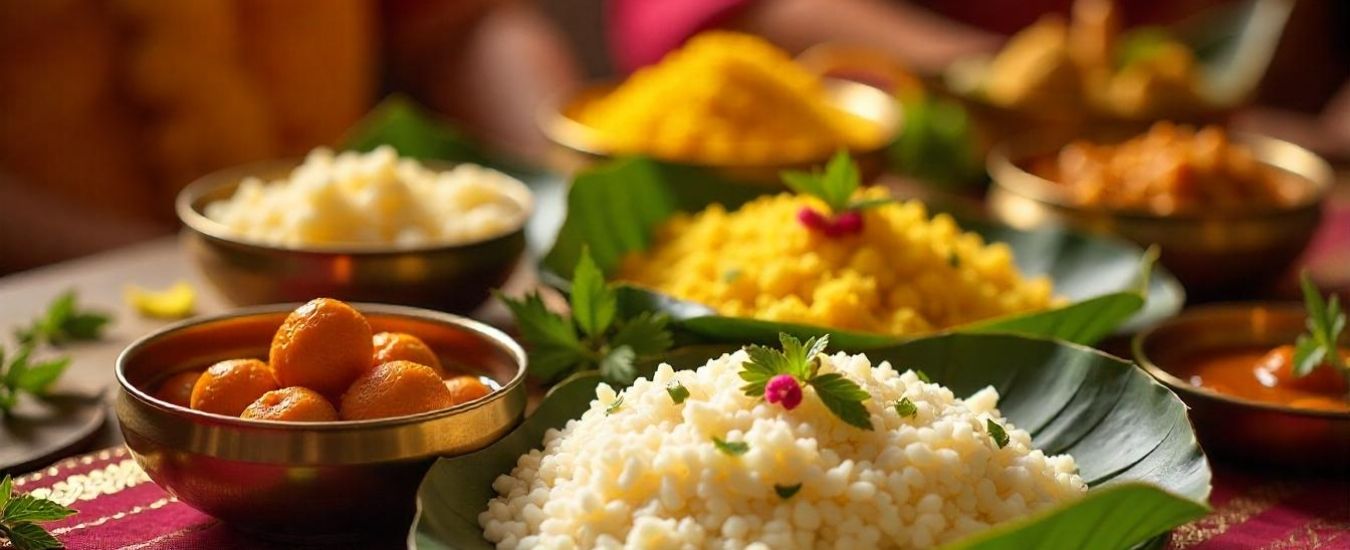If you’ve ever had the joy of attending a Bengali Hindu marriage, you know it’s far more than a union—it’s a living expression of cultural heritage layered with ancient marriage rituals in Bengal that span days of colorful, symbolic events.
Let’s unravel the magic behind a Bengali wedding mandap, where tradition, symbolism, emotion, and food come together in a festival of love.
A Bengali wedding is a Hindu wedding tradition deeply rooted in heritage and family values. It goes beyond rituals—it’s an ensemble of music, blessings, traditional bridal jewellery, and joyous get-togethers that feel like poetry in motion.
The Blend of Tradition, Emotion, and Celebration
From the moment the bride is pampered with Haldi Mukha to the final step at the Bou Bhat, each ritual holds deep spiritual significance, creating a bridge between ancestral customs and modern love stories.
Pre-Wedding Rituals: The Journey Begins
Aiburo Bhaat – The Bachelor/Bachelorette Feast
A joyful meal where the family serves the bride/groom, this tradition includes laughter, Panchali (ritualistic chants), and piri gacha (decorated stool) ceremonies.
Ashirbaad – Seeking Blessings from Elders
Elders shower blessings with husked rice and gold. The bride also receives her Lajja Bastra, a cloth representing purity and acceptance.
Gaye Holud – The Turmeric Ceremony
This vibrant ritual features the application of turmeric for auspiciousness.
- Bride’s Gaye Holud – She’s dressed in yellow, adorned with Chandan Bindi and floral jewelry.
- Groom’s Gaye Holud – Simpler but equally symbolic; it may include Topor, the conical wedding headgear.
The Wedding Eve: Anticipation and Excitement
Dodhi Mongol – The Sacred Dawn Meal
This includes curd and puffed rice before the bride and groom begin their wedding fast.
Tattwa – Exchange of Gifts
Families exchange Tattwa trays filled with sarees, sweets, Bonti (ritual lamp), and cosmetics.
Wedding Day Ceremonies: A Sacred Union
Bor Jatri – Groom’s Procession
Accompanied by Dhunuchi Naach, drums, and dancing, the groom arrives with flair.
Bor Boron – Welcoming the Groom
The bride’s mother welcomes the groom with an aarti, water, and symbolic items.
Shubho Drishti – The Sacred First Glance
The bride slowly removes the betel leaves, revealing her face to the groom.
Mala Bodol – Exchange of Garlands
On a lifted platform, cousins hoist the couple while they exchange garlands—a lively start!
Sampradan – Handing Over the Bride
Elders from the bride’s family recite chants and hand over the bride in a moment of deep sentiment.
Yagna and Saptapadi
In front of the Pancha Pradeep and holy fire, the couple takes seven sacred vows.
Sindoor Daan – Acceptance
The groom applies vermillion to the bride’s parting, finalizing the union.
Post-Wedding Traditions
Bashor Ghar – Playful Night
Games, riddles, teasing, and bond-building activities go on through the night.
Biday – Emotional Goodbye
The bride, now draped in Kanakanjali, departs tearfully, symbolizing detachment and transition.
Bou Bhat – Grand Welcome
She cooks and serves her in-laws as a gesture of acceptance.
Cultural Symbolism in Bengali Weddings
Shankha Pola and Alta
Sakha-Pola are essential symbols of married life. The bride’s feet, painted in red Alta, represent fertility and beauty.
Traditional Bengali Bridal Attire
A red Banarasi saree, Kaan Bala (earrings), Topor, and a large red bindi complete her regal look.
Music and Folk Traditions
From the hypnotic beat of uludhwani to the soothing shehnai, every sound tells a story.
Bengali Wedding Food: A Culinary Heritage
Traditional Wedding Feast
From Shorshe Ilish and Chhanar Dalna to Basanti Pulao, the cuisine is indulgent and symbolic.
Sweets That Sweeten the Bond
Iconic sweets like Rosogolla, Sandesh, Mishti Doi, and Chomchom signify sweetness in married life.
Modern Twists to Traditional Bengali Weddings
Fashion Fusions
From lehengas to minimalist sarees with temple jewellery, fusion fashion trends are emerging.
Destination Weddings
Beaches, forests, and palace weddings bring Bengali weddings to the global stage.
Eco-Friendly Celebrations
From organic Alta to biodegradable décor—modern weddings are marrying sustainability and tradition.
A Bengali wedding is a powerful blend of sacred rites, poetic symbolism, and joy. Every ceremonial detail—from Anjali to Biday—tells a story passed down through generations.
It’s not just a wedding—it’s a cultural celebration with a heartbeat.
FAQs
What makes Bengali weddings unique?
They combine deep Vedic rituals, vibrant music, and generational customs like Shubho Drishti and Mala Bodol.
How long does a Bengali wedding last?
Typically 3 to 5 days, covering everything from Haldi Mukha to Bou Bhat.
What are some must-have elements?
Piri gacha, Topor, Sakha-Pola, traditional sweets, Ludhiana, and emotional send-offs.
Can outsiders participate?
Yes! Bengali weddings are inclusive and community-driven.
Can you plan a minimalist Bengali wedding?
Absolutely—with eco-conscious décor and symbolic rituals, minimalism blends beautifully with tradition.
